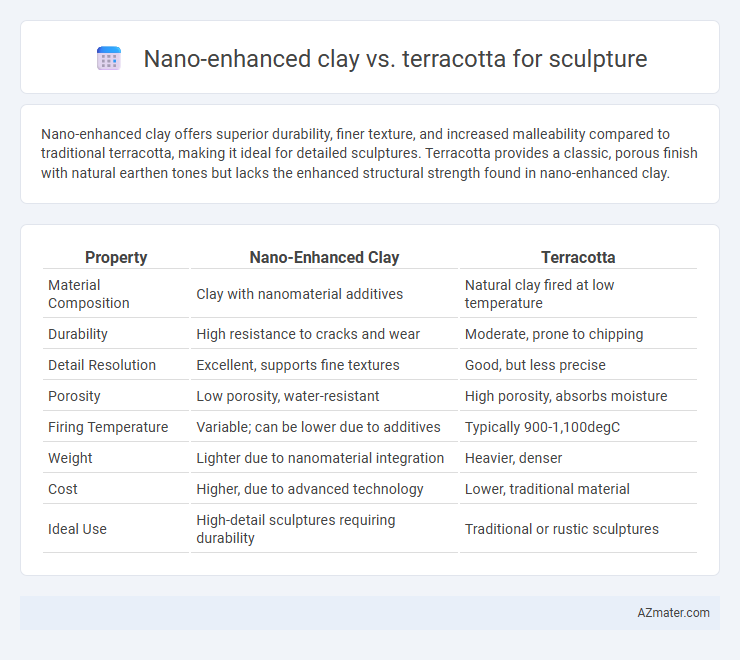Nano-enhanced clay offers superior durability, finer texture, and increased malleability compared to traditional terracotta, making it ideal for detailed sculptures. Terracotta provides a classic, porous finish with natural earthen tones but lacks the enhanced structural strength found in nano-enhanced clay.
Table of Comparison
| Property | Nano-Enhanced Clay | Terracotta |
|---|---|---|
| Material Composition | Clay with nanomaterial additives | Natural clay fired at low temperature |
| Durability | High resistance to cracks and wear | Moderate, prone to chipping |
| Detail Resolution | Excellent, supports fine textures | Good, but less precise |
| Porosity | Low porosity, water-resistant | High porosity, absorbs moisture |
| Firing Temperature | Variable; can be lower due to additives | Typically 900-1,100degC |
| Weight | Lighter due to nanomaterial integration | Heavier, denser |
| Cost | Higher, due to advanced technology | Lower, traditional material |
| Ideal Use | High-detail sculptures requiring durability | Traditional or rustic sculptures |
Introduction to Modern Sculpture Materials
Nano-enhanced clay offers superior durability, increased strength, and finer detail resolution compared to traditional terracotta, making it a preferred material for contemporary sculptors seeking precision and longevity. Terracotta remains valued for its natural aesthetic, affordability, and historical significance, but its porous nature and susceptibility to cracking limit its use in modern, high-detail works. The integration of nanotechnology in clay materials revolutionizes sculpture by enhancing physical properties and expanding creative possibilities in modern art.
What is Nano-enhanced Clay?
Nano-enhanced clay is a cutting-edge material infused with nanoparticles that improve its strength, flexibility, and drying time compared to traditional terracotta. These nanoparticles enhance the clay's molecular structure, resulting in finer details, increased durability, and resistance to cracking during the sculpting and firing processes. This innovation makes nano-enhanced clay ideal for artists seeking precision and longevity in their sculptures, unlike terracotta, which is prized for its natural texture but is more fragile.
Traditional Terracotta: An Overview
Traditional terracotta, composed primarily of natural clay mixed with water and fired at moderate temperatures, offers porous and breathable qualities ideal for sculpture. Nano-enhanced clay incorporates nanoparticles to improve strength, durability, and surface finish while retaining the earthy texture associated with terracotta. While terracotta remains favored for its historical authenticity and ease of sculpting, nano-enhanced variants provide advanced mechanical properties and resistance to weathering, expanding artistic possibilities.
Material Composition and Properties Comparison
Nano-enhanced clay incorporates nanoscale particles such as silica or alumina, significantly improving mechanical strength, thermal stability, and surface smoothness compared to traditional terracotta, which is composed primarily of fired natural clay with iron oxide. The enhanced microstructure of nano clay allows for finer detail retention and reduced porosity, resulting in increased durability and resistance to cracking, while terracotta remains more porous and susceptible to environmental damage. These material properties make nano-enhanced clay ideal for intricate sculptures requiring longevity and precision, whereas terracotta is often favored for its natural aesthetic and historical authenticity.
Sculpting Techniques: Nano Clay vs Terracotta
Nano-enhanced clay offers superior malleability and precision for intricate sculpting techniques compared to traditional terracotta, allowing artists to achieve finer details and smoother finishes. Its enhanced particle structure reduces cracking and shrinkage during drying and firing, improving durability and longevity of sculptures. Terracotta, while versatile and historically favored for its natural texture and earthy aesthetics, requires more careful moisture control to prevent warping, making it less ideal for ultra-fine or delicate sculptural work.
Durability and Longevity in Sculptural Works
Nano-enhanced clay offers superior durability and longevity compared to traditional terracotta due to its reinforced molecular structure, which significantly reduces micro-cracking and erosion over time. The incorporation of nanoparticles enhances the clay's resistance to environmental factors such as moisture, temperature fluctuations, and UV exposure, extending the life span of sculptural works. In contrast, terracotta, while aesthetically pleasing, remains more susceptible to weathering and physical degradation, necessitating more frequent conservation efforts.
Aesthetic Differences and Artistic Potential
Nano-enhanced clay offers superior smoothness and finer detail resolution compared to traditional terracotta, allowing artists to achieve highly intricate textures and vibrant finishes. Its enhanced malleability supports innovative sculpting techniques and enables more complex, delicate forms that are difficult to craft with terracotta. Terracotta retains a classic, earthy aesthetic with warm, natural tones that contribute a timeless, rustic charm, whereas nano-enhanced clay allows for a broader range of color applications and surface treatments, expanding artistic potential.
Environmental Impact and Sustainability
Nano-enhanced clay significantly reduces environmental impact by requiring less water and energy during processing compared to traditional terracotta. The incorporation of nano-materials improves durability and longevity, minimizing the need for frequent replacements and reducing overall material consumption. Terracotta, while natural and biodegradable, involves energy-intensive kiln firing with higher carbon emissions, making nano-enhanced clay a more sustainable choice for eco-conscious sculptors.
Cost Effectiveness and Accessibility
Nano-enhanced clay offers superior strength and durability, reducing long-term costs by minimizing repairs and preserving sculptures better than traditional terracotta. While terracotta remains widely accessible and affordable for beginners due to its natural availability and lower upfront price, nano-enhanced clay's advanced properties justify its higher initial investment for professional artists seeking longevity. Cost effectiveness depends on the balance between material expense and the durability requirements of the sculpture project.
Choosing the Best Material for Your Sculpture
Nano-enhanced clay offers superior flexibility and durability compared to traditional terracotta, making it ideal for detailed and long-lasting sculptures. Its nano-particles strengthen the material, reducing cracking and enhancing fine texture retention, which is crucial for intricate designs. Terracotta remains a classic choice valued for its natural earthy aesthetic and affordability, but nano-enhanced clay provides advanced performance for artists seeking resilience and precision.

Infographic: Nano-enhanced clay vs Terracotta for Sculpture
 azmater.com
azmater.com